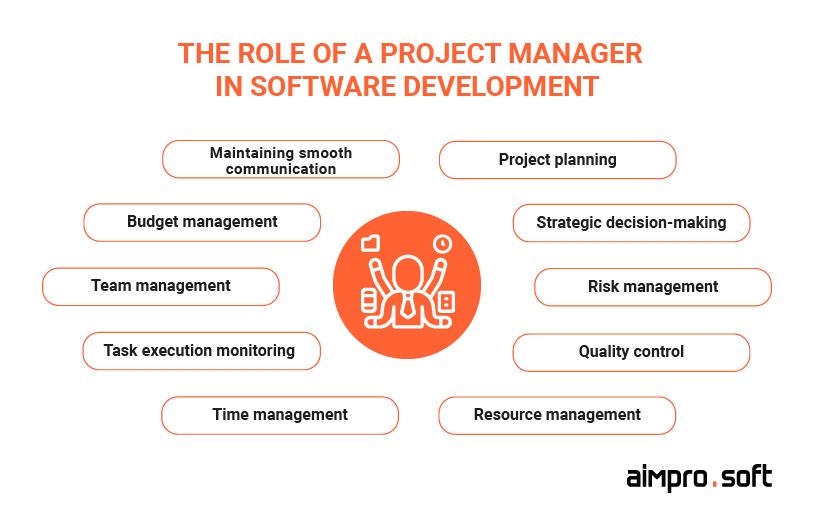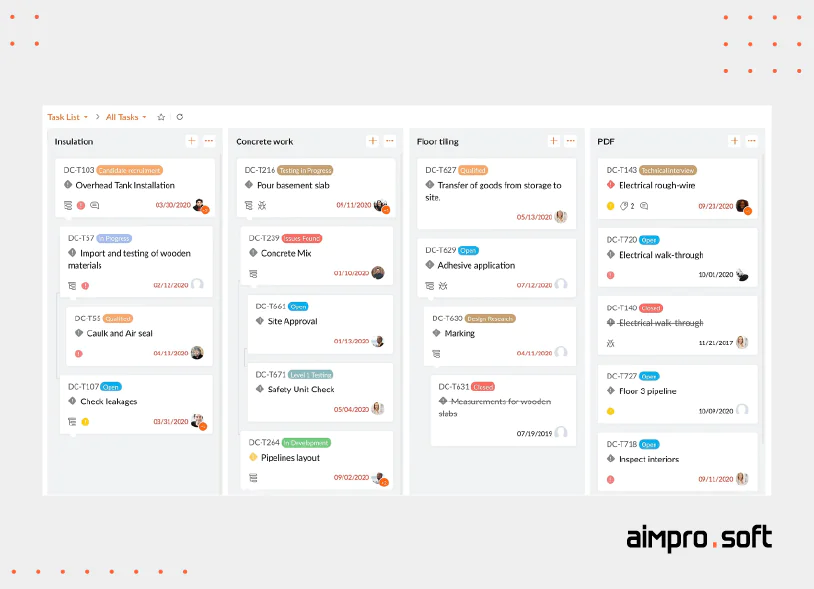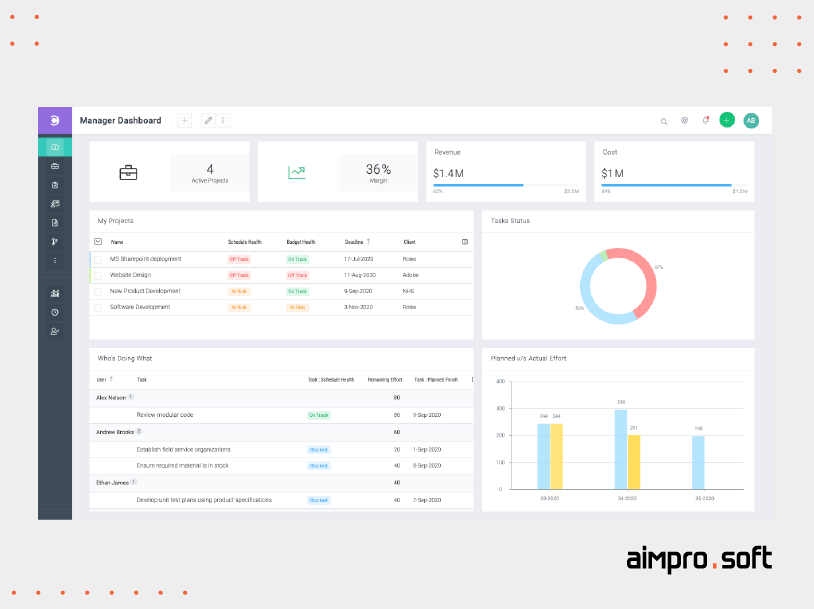Guide to Successful Software Development Team Management

Key takeaways
- Learn the importance of project management in software development and find out who can take on this responsibility apart from a project manager.
- Explore the key benefits of engaging a project manager in your project, such as proper resource allocation, timely product delivery, risk elimination, and others.
- How to manage a software development team to avoid common challenges? Get information on the key steps to follow.
- Is it possible to manage developers without technical knowledge? Read on to find out how.
- Remote working formats are at the height of popularity right now. It pays to be prepared to manage an external development team. Get our pro tips on managing software development teams in the remote format.
- Project manager tools are your trusty assistants. We have prepared a selection of the most useful software development management tools for you.
When it comes to the management of the development team, there are challenges that can often emerge when there is an incorrect management approach integrated or there is an absence of a skilled manager at all. It usually leads to misunderstanding among team members and the client, budget overruns, tech debt, improper resource allocation, and other aftermaths that can be easily avoided with the correct management strategy.
Whether you plan to manage the project on your own or hire a dedicated PM, as a business owner, it’s essential for you to know the way efficient team management works and best practices to overcome risks. Luckily, even without extensive technical knowledge, you can use tools and integrate the correct methodology to ensure a successful product release. That’s why we have prepared for you a detailed guide to project management, which will help you to close all your questions about how to avoid miscommunication, meet deadlines, build a clear plan, and complete the project within budget.
Understanding software development team management
Managing a software development team refers to the planning, coordinating, controlling, and ensuring of the seamless deployment of software products. All the software development activities are coordinated under the project management framework. This involves outlining the prerequisites for the project, developing a project plan, assigning resources and following up until the completion of the project.
Effective communication skills are a must in software project management to manage the expectations of team members and stakeholders skillfully. In addition, project management includes risk management, proactively identifying potential problems before they turn into difficulties that can prevent the successful completion of the project. By adhering to industry best practices and using modern tools and PM methodologies, organizations can successfully deliver high-end software products, achieving set business objectives.
Project management serves as the orchestration of tasks, resources, and timelines to ensure successful project delivery. Traditionally, a project manager carries this responsibility, adeptly navigating the intricacies of planning. However, some projects opt for a leaner approach, forgoing a dedicated PM and entrusting management duties to alternatives. So, besides a project manager, who can manage a development team?
- Client
A client may take on a more active project management role in the case of small-scale projects for the sake of saving money and when it comes to internal product development.
- Tech leader
Responsible for the technology aspects of the development team. Primarily responsible for making technical decisions and leading the team.
- Team leader
Leads a specific group of specialists within the entire development team. Focuses on team dynamics, collaboration, and task delegation.
- Scrum master
Facilitates the Scrum process to ensure the team follows agile principles. Focuses on improving team performance and removing obstacles.
- Business analyst
Analyses business needs, processes, and systems. Collaborates with development teams to ensure the project aligns with business goals.
It is worth remembering that although these professionals can lead and manage the project, their scope of work remains narrower than that of a project manager. The PM provides a holistic vision by seamlessly integrating the various aspects of the project. Let’s take a closer look at the role of the project manager to identify the true value of this expert.
The role of project managers in software development
Project managers usually not only acquire professional skills but also have innate ones. What do we mean by stating that? According to Aimprosoft project managers, a good PM should love interacting with people and, therefore, be able to build good communication, as well as not be afraid of change and be ready for any circumstances. Therefore, a good project manager is worth its weight in gold. Check out the section below to see those points that confirm the value of such a specialist.

The role of project managers in software development
Project planning
The primary role of the project manager is to create a detailed plan that ensures that the project objectives are achieved within the agreed budget and timeframe. This plan serves as a roadmap from project ideation to completion. It includes the project scope, required resources, expected time and cost, communication strategy, execution and documentation plans, and a proposal for ongoing support and maintenance.
Time management
Project managers also plan schedules based on the nature of tasks and provide sufficient time for all stages to allow a proper project schedule structure. Project managers also identify priorities, ensuring efficient concepts and setting a clear point of focus on the timely completion of crucial tasks.
Task execution monitoring
Task monitoring is a key activity of the project manager that involves controlling and tracking the progress of tasks and work within the entire SDLS. Project managers aim for flexibility since they know every plan is subject to unexpected challenges. This does not mean that the planning stage should be ignored completely; instead, it involves developing a flexible plan to accommodate such difficulties as client issues and operational problems.
Team management
Project managers lead and motivate development teams, fostering cooperation and ensuring that all team members work towards the project goals. They provide guidance, resolve conflicts, and maintain a positive team atmosphere.
Budget management
Good project managers know how to keep projects within given budgets. While on-time delivery of the project and meeting client expectations is important, as the overall success of the project depends on it. Skillful project managers constantly monitor and proactively plan the budget to ensure that it is not significantly exceeded. By prioritizing regular budget reviews and strategic forecasting, they ensure financial discipline and contribute to the overall success of the project.
Maintaining smooth communication between all parties
Project managers can genuinely be described as the liaisons between the stakeholders and the development team involved in the project. This responsibility encompasses effective communication and also teamwork with the executive leadership, cross-functional teams, and external stakeholders. They are conduits of communication to ensure that all parties are aware of the project’s goals, requirements, and limitations. Project managers promote closer integration between the stakeholders by keeping the communication lines open.
Strategic decision-making
The duties of the project manager also involve making sure that the objectives of the project are in line with the wider strategic purposes and vision of the organization. Managers participate in decision-making activities that determine the general trajectory of the product development process, ensuring that the deliverables obtained at certain milestones meet the set goals.
Risk management
As the scope of the project increases, the likelihood of encountering unexpected problems not foreseen in the original plan increases. While setbacks are inevitable, experienced project managers can systematically identify and assess potential risks beforehand. Their skill lies in thoroughly assessing risks in advance to prevent or at least mitigate their impact on project success.
Quality control
Quality control is like the project’s superhero cape that a project manager wears. One of the project managers’ primary responsibilities is to ensure that the development team carries out everything in the project to the highest level. These specialists ensure that every stage of the project, from planning to execution, is in line with the goals and vision of the client. This is often achieved through solid planning, communication with the team, and milestone checking. The project manager checks for any inconsistencies and errors to ensure the project’s quality is being met.
Resource management
Primarily, adept project managers delineate the project’s scope and assess the available resources. They possess the skill to establish realistic time estimates and evaluate the team’s capacities. Subsequently, they formulate a comprehensive and succinct plan to execute the project while concurrently overseeing its progression. Given the inherent unpredictability of projects, proficient project managers exhibit the ability to make necessary adjustments throughout the project lifecycle before reaching its ultimate stages.
It is worth recognizing that most projects require hiring project managers. It is better to introduce a PM into the project from the early stages of the project who will reliably and consistently support the performance of the entire development team.
Why is competent project management of the development team so important?
The importance of project managers can be seen in the increased value that is achieved by implementing innovative strategies that improve resource efficiency and maintain project quality. Project managers are essential to project success, primarily through their technical competencies. Let’s take a closer look at the benefits of engaging a skilled PM in your project.
Alignment with project objectives
The mismatch between project and business objectives is known to be the cause of 44% of project failures. Project managers, in turn, act as the driving force behind the project’s success, carefully aligning every aspect of the project with its predetermined objectives. They work to understand the underlying business objectives, interpret stakeholder expectations, and translate them into a project plan. On the other hand, organizations that use project management techniques achieve a 92% success rate in meeting project goals.
Budget control
You may face 11.4% of resources being wasted due to poorly executed project management processes. Project managers are adept at budget management and controlling project finances to ensure that costs are not exceeded. They develop accurate estimates, allocate resources wisely, and control costs throughout the project lifecycle.
Resource allocation
Project managers know how to optimally allocate resources, ensuring tasks are assigned to team members with the right skills. By managing resources strategically, project managers increase efficiency and productivity, resulting in the successful and timely completion of project tasks.
Stakeholder communication
Forbes reports that poor communication between IT and business counterparts remains the primary contributor to project failure. Project managers are the link between the development team and stakeholders. They facilitate clear and concise communication, ensuring all stakeholders are informed of project progress, milestones, and potential issues.
Risk mitigation
According to project management statistics, 27% of organizations always apply risk management to avoid the possibility of project failure. Identifying and mitigating risks is a special skill of project managers. They conduct a comprehensive risk assessment, develop a risk mitigation strategy, and implement contingency plans.
Timely completion of tasks
The PM has effective skills in setting practical deadlines and schedules for projects. Statistics show that companies hiring project managers complete projects timely and within budget in 63% of cases. With proper task planning and monitoring, they ensure that things get done on time, thus avoiding delays and sustaining the pace of a project. This timely completion contributes to the project’s success and client satisfaction.
So, we’ve covered the main benefits of hiring a PM and the importance of good management. Given the vital role of PM in effectively coordinating your product, you may realize that building a team without such a specialist is quite risky. Moreover, the cohesiveness of the developers’ work and the achievement of stakeholder goals depend on their presence. Now, let’s examine the main actions a project manager should perform on the way to a successful product release.
How to manage development teams: key activities to complete
As we dive further into the field of project management, let’s explore a few useful practices that serve as a key to unlocking the door to project success. Whether you are going to engage a dedicated PM or manage the project yourself, this section will help you understand the key steps that should be completed so that the outcome matches the expectations in the end.

The main actions to be performed when managing a development team
Defining clear expectations and deliverables
Firstly, the client should be actively involved in the collaborative management of the project in defining its goals. Therefore, before starting the project, the client should go through the discovery phase; this phase is dedicated to collecting the necessary artifacts and creating the SRS documentation (software requirements specification).
During this phase, the project manager simultaneously oversees the discovery process, ensuring effective communication between the client and the business analyst. The BA plays a central role in gathering the necessary artifacts and creating the documentation. The discovery phase is essential to the project as it establishes a clear understanding of the project requirements and objectives. Such a proactive attitude helps to reduce communication breakdowns at the later stages of projects and sets up favorable conditions for further collaboration.
Conducting a discovery phase can reduce the risks of project failure. Read our article to learn more about the importance of this step.
Choosing relevant project methodology
The right methodology can provide clarity of task execution and set the right project delivery trajectory. To make an informed choice, project managers must first assess the project’s unique requirements, considering factors such as scope, project complexity, resource availability, project timeline, and degree of required adaptability to changes. The choice of the methodology requires a careful evaluation to use its pros to a full extent and not to jeopardize the project’s success in case of a wrong decision. Let’s review a few popular approaches in a comparative table:
| Methodology | Essence | Benefits | Best applied for |
|---|---|---|---|
| Agile | An iterative and flexible approach to project management that values adaptability and customer collaboration over strict planning. | Continuous adaptation, transparency, collaboration, and customer-centric focus. | Agile is suitable for projects with evolving requirements and a need for flexibility. It accommodates possible changes. For example, it is suitable for a project that involves updates and changes in some functions. |
| Scrum | A specific Agile framework that emphasizes iterative development, with roles like scrum master, product owner, and defined ceremonies like Sprint Review. | Iterative development, defined roles, and prioritization through a product backlog. | Ideal for projects that require frequent iterations and prioritized backlog. For instance, for building a website with multiple features, where the development team uses regular sprints to deliver and test functionality. |
| Waterfall | Sequential project management methodology where tasks follow a linear progression, moving through distinct phases. | Consistent process, distinct phases (e.g., conception, design, construction), comprehensive documentation. | Waterfall is suitable for projects with well-defined requirements and structure. Also, for projects where each stage (design, building, testing) follows a sequential order. |
| Kanban | A visual project management method that focuses on continuous delivery, limiting work in progress, and utilizing visual boards. | Efficient workflow, work in progress (WIP) limits, continuous delivery. | It’s ideal for projects with a continuous and constant flow of tasks, allowing teams to adapt to changing priorities. Similarly, it is well suited for projects with evolving requirements and processes that may change over time. |
Agile and Waterfall are two popular and well-established methodologies. Learn more about these two approaches to choose the most appropriate one for your project.
Employing tools for project management and time tracking
Time tracking tools provide a transparent overview of team members’ time allocation to various tasks, helping to monitor project progress and anticipate possible delays. In addition, time tracking tools allow the team to offer accurate estimates of task completion times, which is essential for effective communication with stakeholders and setting realistic project timelines. For example, you can use tools such as Asana, ClickUp, Toggl, or Clockify.
Allocating tasks based on developer skills
Reasonable resource allocation makes any project’s productivity, efficiency, and overall success stronger. Optimal allocation of resources ensures that developers work on tasks relevant to their skills so that production increases and wastes are reduced. Efficient resource sharing is allocating people with the right skills to specific tasks on time to ensure optimum team performance, leading to better project results.
So, how to manage software development team and allocate resources among all team members? To begin with, it is worth assessing the skills and experience of each developer. Understanding their strengths and weaknesses will help assign responsibilities according to their capabilities. Also, consider the workload of each developer. Avoid overload and distribute tasks evenly to maintain a balanced workload. Implement a rotation system so that developers can familiarise themselves with different aspects of the project. This not only makes the work interesting but also expands their skill set.
Meeting project deadlines
One of the most vital project management activities is to ensure proper time allocation. This is done by completely understanding the project scope, objectives, resources, risks, and dependencies. Communicating with the team and all stakeholders regarding alignment and commitment is important. Time is also contingency time, and plans are contingency plans. Likewise, breaking the project into smaller tasks improves planning and monitoring. Using tools such as work breakdown structures such as Kanban boards makes visualization and tracking easier.
Also, make sure that you have clearly prioritized your tasks; it’s important to avoid making the mistake of trying to do everything at once. Eliminating or delegating non-essential tasks helps keep focus on the most critical project goals and deliverables. This holistic approach supports effective project management practices to meet deadlines.
Streamlining file management and collaboration
Depending on the size of the project scope, the PM may have to manage multiple tasks related to organizing, storing, and controlling project-related documents. It may include making project documentation related to risk assessments accessible to the team, keeping track of status reports and change requests, managing documentation outlining project requirements, etc.
File and report tracking ensures that team members have access to the most up-to-date information, reducing the risk of errors and misunderstandings. Centralized project document storage simplifies collaboration by allowing team members to work on shared files simultaneously. This not only increases productivity but also promotes transparency and accountability within the team.
To optimize file management, the use of project management software that is designed for this activity can help you. For instance, ClickUp, AdaptiveWork, and Proofhub provide robust file management features, allowing users to organize, share, and work on documents effortlessly. Using these tools, PM can improve file organization, accessibility, and collaboration, ultimately contributing to project success.
Efficient change control
Change always comes unexpectedly, just as no project is without change. Proper change management is important to prevent problems, so any agreed changes should be documented and fully communicated to avoid confusion. Utilising project management tools specifically designed for change management and focusing on automating the change management lifecycle before final decisions are made can improve clarity.
Implementing a checklist listing key individuals on the project helps streamline the approval process. While it may seem that this procedural approach slows down the agility of change, it reduces confusion and prevents waste of resources. Despite the temptation to take shortcuts, having clear procedures ensures that everyone is on the same page and minimizes reliance on rumored agreements.
Real-time updates monitoring
Real-time monitoring in project management entails frequent tracking, data analysis, and adjustments of ongoing activity with the latest information from different sources. Project managers usually employ tools for monitoring completed tasks, milestones, and deadlines. This constant tracking creates prompt identification of progress or deviations so the development team can act on time-appropriate information. For monitoring updates, you can use tools such as Wrike, Asana, or Stafiz.
Similarly, regular project data monitoring can help find any deviations or disparities from the set trajectory. This enables teams to deal with potential issues rapidly, reducing risks and protecting them from turning into even bigger ones. By making resource allocation decisions based on current, reliable data, you ensure that the project runs smoothly.
So, we have covered the basic steps that every project manager should take during project implementation to ensure that the project and its execution meet the initial objectives. However, we have to examine one more important aspect since there is a misconception that you need to have strong technical knowledge to manage a development team. Hence, let’s see how to manage a software development team if you are not a tech-savvy person.
Leading a team of developers without a tech background
Having a strong tech background may be beneficial, but it’s mandatory to understand how your team members perform their tasks and coordinate all the processes. While you may not understand the technical nuances, you can still manage risks, understand common challenges, and drive the project to the desired outcome. Let’s explore key tips that should be followed to ensure that the absence of sufficient tech knowledge won’t affect the management of your project.

Tips for managing a development team if you’re not tech-savvy
Respect and understand developers
Don’t think that developers are robots who just generate code and have no need for a comfortable working environment. Each member of the development team can work at their own pace, and it is worth considering and listening to their wishes. Don’t be too biased, give them the freedom and opportunity to solve some problems independently. Don’t evaluate only code quality and number of bugs; focus more on how many bugs were fixed and what the final result of the completed part of the work was.
Motivation techniques
Instead of forcing motivation, project managers can influence it by creating conditions that encourage team members to give their best. The main factors that contribute to team motivation are goal and autonomy. The development team management will be more productive if they know exactly what the primary goal of their tasks is. They must be aware of what the end result will be.
Another critical element is autonomy, giving teams control over how and when they work. Studies show that a sense of control over the working environment significantly increases productivity levels in the workplace. Therefore, it is not necessary to control every action of developers but rather encourage their suggestions.
Don’t get fixated on the estimate
Effective project management recognizes that time estimation is inherently uncertain, especially in an area as complex as software design and development. Unforeseen difficulties often arise in software development. It is essential to treat delays sympathetically, recognizing that they do not necessarily reflect the incompetence of software developers. To mitigate potential setbacks, prudent project managers incorporate flexibility into deadlines, allowing for unforeseen problems or specification changes beyond the developers’ control. To minimize delays, you can collaborate with specialists with experience in similar projects, improving the accuracy of estimates and calculations.
Providing necessary resources
As the leader of a development team, you must first realize that your team members are the main driving force behind the project’s success. While their skills and experience are essential, it is important to understand the complexity of human resources, as each developer may have a different idea of how to approach work. It’s vital to prevent potential conflicts and personality clashes and focus on empowering and motivating your team for sustainable growth. Effective software development team management includes allocating resources, tracking availability, and managing absences due to sickness, holidays, or burnout.
Implement tools such as attendance tracking software to simplify absence management by providing a complete overview of team availability. Additionally, understanding and managing financial resources is paramount. Plan and document financial resources early in project development to ensure that human resources, material resources, and other project costs are funded. Incorporating these practices into your project management approach will contribute to the overall success of your development team.
Shielding from unnecessary distractions
Keeping the project team free from unnecessary distractions is essential to maintaining concentration. To achieve this, maintain clear and open communication channels within the team. Clearly define roles and responsibilities so that everyone understands their tasks. Help your team prioritize tasks and focus on critical activities. Encourage using tools such as calendars, project management software, and task lists to organize and prioritize work.
At critical project stages, minimize unnecessary meetings and interruptions so that team members can focus on their tasks without unnecessary disruption. By incorporating these strategies, project managers can shield their teams from distractions, promoting a more focused and productive work environment.
Recognizing individual and team achievements
Recognizing individual and team achievements increases motivation during development. Therefore, acknowledge and reward achievements as soon as they occur. Prompt recognition encourages positive behavior and maintains high performance. Always provide constructive feedback. Explain clearly what specific actions or results contributed to the success to reinforce the desired behavior for future projects. Emphasize the collaborative nature of achievements. Recognize not only individual efforts but also the collective success of the team. This promotes a sense of unity and shared accomplishments.
We have provided important tips for managing software development while not having a strong tech background. Having explored tips that aim to help you conduct management processes seamlessly, it’s equally crucial to explore the most common mistakes that should be avoided by all means in order not to jeopardize your project’s success.
Contact us, and we will find you the top project managers to take your project to success.
CONTACT USMajor mistakes in development team management
Aimprosoft’s project managers have identified some of the most common mistakes in leading a development team. These mistakes are so obvious yet so easy to make. But don’t worry, we have also prepared tips on overcoming them.
Lack of transparency in the development process
One of the common mistakes in managing software development is the need for more transparency in the process. This can lead to various problems, such as miscommunication and misunderstanding of the project’s progress, making it difficult for stakeholders to cooperate. Transparency promotes honesty and openness, building trust between team members. All team members should be aware of the goals and values of the project; this fosters a working atmosphere. When everyone understands the team’s goals and progress, they cooperate more effectively. Transparent communication also helps to identify bottlenecks and problems early on, preventing project delays.
Confusion among stakeholders about the scope of their responsibilities
An essential issue in project management is the poor understanding of stakeholder responsibilities, which creates miscommunication risks and causes delays in decision-making and scope creep. For this, stakeholder onboarding sessions need to be thorough, as transparent communication channels and detailed documentation are essential. Stakeholders’ engagement and informedness are two other significant factors influenced by regular project updates and a feedback mechanism. By facing this challenge squarely, project managers can foster clarity that reduces uncertainties.
Fuzzy communication
Lack of communication in software development can manifest as unclear project goals and inadequate communication of progress, often resulting from assumptions or lack of open dialogue. This problem is common to both fast-growing startups, where structured communication processes can be missed in the rush to scale, and large enterprises facing bureaucracy and departmental silos that create barriers. The solution is to develop a comprehensive communications plan that includes regular team meetings, individual meetings, and transparent documentation.
Poor time management
Bad time management and scheduling conflicts are often the result of managers setting impossible deadlines, ignoring the complexity of tasks, or failing to consider the team’s individual abilities, leading to burnout, poor quality of work, and missed deadlines. To avoid this, manage time together by involving the team in planning. Also, using time-tracking tools provides insight into the length of the working day, enabling data-driven decisions to optimize schedules and workloads.
Violation of deadlines, hence the project budget
Timing violations in project management can seriously affect the project budget, often resulting in cost overruns and financial difficulties. There are several factors behind the schedule slippage, such as unreasonable project deadlines, poor pre-planning, unexpected complications, and resource shortages. To address this issue, project managers have to use many advanced project planning strategies, realistic schedules and also continuous progress monitoring. If proactive risk management is applied and potential bottlenecks are identified within the lifetime of a project, then the delays can be prevented.
Overall, it is worth summarising that addressing these mistakes involves fostering a culture of openness, providing clear communication channels, and ensuring stakeholders comprehensively understand their roles and responsibilities throughout the development process. Now, we can shift the focus to another important aspect: remote team management, and explore the tips to make it work.
Managing and leading remote development teams
Remote working has become an integral part of our lives these days. Managing software teams remotely can be daunting for even the most experienced managers. Thankfully, many practices and tips can ease this burden. In this section, we will tell you how to organize an effective process for managing a remote development team.
Build trust in remote teams
To establish trust in remote software development teams:
- Prioritize transparent communication, consistent commitment, and demonstration of reliability.
- Create an atmosphere of open communication by regularly sharing relevant information and providing ongoing feedback.
- Recognize and mark the hard work and achievements of individual employees or the entire team.
- Publicly recognize their contributions, boosting morale and building trust.
Encouraging peer recognition further builds team cohesion and trust.
Leverage collaboration tools
With the proliferation of remote working, remote team software has become vital for managing development team and communicating with remote teams. Choosing the right tools is very important to manage a remote team effectively. When team members work in different locations, communication tools are key to keeping everyone on the same page and always completing all tasks on time.
Here are a few tools to help you communicate with your remote team:
As far as communicating with the remote team is concerned, all these applications have features that can be useful for management.
Establish regular feedback mechanisms
Establishing a procedure for sharing progress and problem-solving information strengthens team cohesion, mainly when team members are scattered worldwide. Plan weekly progress meetings to encourage open communication among team members. At these meetings, you can share updates on development processes, discuss achievements, and solve problems. This is an opportunity for the entire team to keep abreast of each other’s work, identify potential obstacles, and provide mutual support and guidance.
In addition to meetings, project management tools can increase transparency and visibility into the workflow. Sometimes, meetings can be time-consuming, so feedback can be given in writing through management tools.
Pay proper attention to different time zones
When managing software development remote teams spread across different time zones, it’s worth creating a concept like ‘shared time’; you need this to ensure synchronized collaboration. Here are some tips to help you build time management across time zones:
- Establish communication principles: Clearly define communication rules, emphasizing the importance of responding to requests within typical working hours.
- Embrace asynchronous communication: While synchronous conversations are essential, asynchronous communication is just as important. Create a balance by using tools and practices that allow team members to collaborate effectively across time zones, even beyond “common time.”
- Ensure time zone awareness: Maintain a sense of time zone awareness within the team. Use visual aids such as shared calendars showing ‘common time’ to raise awareness and minimize scheduling conflicts.
Monitor progress against KPIs
Developing key performance indicators (KPIs) is a critical quantifiable metric that allows project managers to measure the performance of a remote development team and track project progress. These KPIs offer team members clearly defined goals that promote focus and commitment.
Consider these practical tips for using this metric effectively:
- Strategically align KPIs: Defining KPIs that align with the project and the company’s overarching goals is important. Ensuring that KPIs are specific, measurable, achievable, realistic, relevant, and time-bound (SMART) increases their achievability.
- Regular monitoring and evaluation: Consistent monitoring and evaluation of KPIs provides valuable information about the team’s performance, helping to identify areas for improvement. Recognizing achievements and progress toward KPIs is critical to team motivation and engagement.
- Involve the team in setting KPIs: By involving the team in setting KPIs, it will be easier to identify any obstacles or problems that may hinder the achievement of the goal and enable the team to come up with creative solutions.
KPIs prove to be very useful when managing a development team, providing a framework for setting clear expectations, which is very important in a remote working environment.
If you follow these tips, managing software development remote team will become challenge-free for you. We have already discussed tools that are an integral part of remote team management, which contribute to more convenient collaboration. In fact, such tools are needed not only for remote teams but for any other teams as well. Below we will give you a list of the best tools for development team management.
Looking for more tips for managing remote teams? Read our detailed guide on the topic.
Leveraging tools for development team management
A robust project management tool can make your job much easier. You can use one advanced platform, or you can combine several. We have provided you with a selection of reliable and convenient platforms for project management below.
1. Jira

Jira interface
Jira is a robust operations management suite designed to optimize project management. Central to Jira is a versatile issue-tracking system that allows teams to create, track, and manage various project-related elements through customizable workflows.
Main features:
- Issue tracking
- Agile boards
- Custom workflows
- Reporting and dashboards
Advantages:
- Flexibility: Adaptable to various project management methodologies.
- Integration: Seamlessly integrates with other Atlassian tools like Confluence and Bitbucket.
- Scalability: Scales well for both small teams and large enterprises.
2. Zoho Projects

Zoho Projects interface
Zoho Projects is a robust project management software with comprehensive tools for effective task management and project planning. With a user-friendly interface, it offers schedules and powerful collaboration features, including live chat and document sharing. The software supports time tracking, bug tracking, and testing of software development projects.
Main features:
- Task management
- Time tracking
- Document collaboration
- Chat for real-time communication
Advantages:
- User-friendly Interface: Easy to navigate and use.
- Integration: Integrates with various Zoho and third-party applications.
- Collaboration: Enhances team collaboration with forums and chat.
3. Celoxis

Celoxis interface
Celoxis is another multi-functional management platform. The system includes tools for task planning, resource management, time management, budgeting, and risk management. Celoxis provides dynamic reports and dashboards for real-time project monitoring. It supports collaboration through document sharing, discussions, and email integration.
Main features:
- Portfolio management
- Resource management
- Financial tracking
- Risk management
Advantages:
- Comprehensive: Covers various aspects of project and portfolio management.
- Customization: Highly customizable to fit diverse project needs.
- Real-time collaboration: Facilitates real-time collaboration among team members.
4. Google Meet

Google Meet interface
Google Meet is a video conferencing and online meeting platform developed by Google. It offers a wide range of virtual communication and collaboration features, making it an ideal choice for project managers. With Google Meet, project managers can schedule and join video meetings directly from Google Calendar or through a dedicated web interface. The scalability of Google Meet allows for small team meetings and large-scale webinars, contributing to its versatility and widespread adoption for remote communication and virtual collaboration.
Main features:
- Video conferencing
- Screen sharing
- Calendar integration
- Real-time collaboration
Advantages:
- Integration: Seamlessly integrates with other Google Workspace tools.
- Accessibility: Accessible from various devices with a simple interface.
- Security: Offers robust security features for meeting privacy.
5. Microsoft Teams

Microsoft Teams interface
Microsoft Teams is a collaboration platform that combines chat, video conferencing, file storage, and integration with Microsoft 365. It serves as a teamwork hub where team members communicate and collaborate in real-time. Microsoft Teams provides streaming communication through channels organized by teams, facilitating structured discussions and content sharing. The platform offers robust security and compliance features, including data encryption and multi-factor authentication, to protect sensitive information. With its extensive capabilities, Microsoft Teams has become a key virtual collaboration tool for effective communication and teamwork.
Main features:
- Chat and messaging
- Video conferencing
- File sharing
- App integration
Advantages:
- Integration: Seamless integration with Microsoft 365 suite.
- Collaboration hub: Centralized platform for team communication and collaboration.
- Security: Built-in security features for data protection.
Conclusion
Effective management of a development team is vital for any software project if you aim for success. It requires additional expenses, but it’s worth the investment. Our guide aims to help you use management tools correctly, avoid making common mistakes, and carry out all the necessary activities so that the outcome meets your expectations.
With these tips, you can build results-oriented communication with your development team, overcome potential obstacles, and ultimately release the product successfully and within allocated resources. If you still have any doubts about whether you can handle managing development teams, you can always contact us. Our experienced project managers are ready to help you with your inquiry and deal with any difficulties you may experience on your way to releasing a successful project.
FAQ
What are the fundamental principles of effective software development team management?
Effective management of a software development team involves several key principles. Clear communication is paramount to ensure that everyone understands the project’s goals. Collaboration and teamwork foster a cohesive work environment, and effective leadership resolves conflicts and aligns the team with project goals. Finally, prompt adaptation to changes in project requirements and a focus on quality contribute to successful software development.
What are the challenges of leading developers without technical expertise?
Managing developers without technical expertise presents challenges such as a lack of understanding of technical complexities, potential for ineffective task estimation, communication barriers, difficulty in problem-solving, and limited guidance for developers. This situation can lead to unrealistic timelines and a lack of necessary support for the development team, which can affect the project’s overall success. Listening to technical experts is important because they are coding and can see all the problems. That’s why taking into account the opinion of all parties is extremely important for the project, and then proper communication will compensate for the lack of technical expertise.
What role does open communication play in leading software development teams?
Open communication plays a crucial role in leading software development teams. It ensures a clear understanding of project requirements, facilitates feedback and collaboration, aids in issue resolution, boosts team morale, and enables adaptability to changes. Effective communication creates a positive working environment, promotes transparency, and contributes to the overall success of the software development process.




